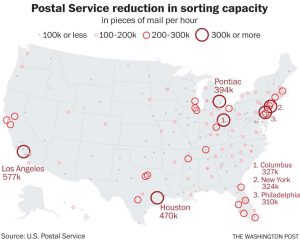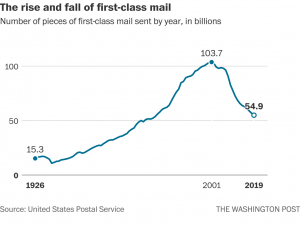AUGUST 20, 2020

A mailbox stands in Fox Point, Wis., on Aug. 18, 2020. Facing public pressure and state lawsuits, the Postmaster general announced Tuesday he is halting some operational changes until after the November election. (AP Photo/Morry Gash)
This week, Postmaster General Louis DeJoy pulled back on a host of cost-saving measures at the U.S. Postal Service after a public outcry over delivery delays and the potential to upset mail-in voting come November. Of particular concern was the removal of hundreds of mail sorting machines.
According to a grievance filed by the American Postal Workers Union and obtained by The Washington Post, the USPS was poised to decommission 671 of the massive machines, roughly 10 percent of its inventory, and capable of sorting 21.4 million pieces of paper mail per hour. The Postal Service, by comparison, processes as much as 500 million items each day.
But USPS officials and industry insiders say the removals were part of a long-range plan, one that reflects Americans’ diminishing use for letters and growing reliance on package delivery.
The 671 machines slated for removal were scattered across 49 states, the District of Columbia and Puerto Rico. At the state level, the removals correlated closely with population: states with more people, and hence a larger USPS footprint, had more machines taken out. California had the greatest number, 76, followed by Florida (59), Texas (58) New York (52) and Ohio (34). Alaska is the only state with machines on the list.
Data published in USPS reports submitted annually to the Postal Regulatory Commission show the agency typically decommissions dozens, sometimes hundreds, of machines each year. However, they also show that this year’s reductions in sorting capacity are larger than they were in prior years.
In 2018, for instance, the agency decommissioned roughly 3 percent of its Delivery Bar Code Sorters, or 125 machines. In 2019, it was 5 percent, or 186 machines. The 671 on this year’s list amounted to about 13 percent.
The agency “routinely moves equipment around its network as necessary to match changing mail and package volumes,” the USPS said in a statement. “Package volume is up, but mail volume continues to decline.”

The machines can label and sort tens of thousands of letters, bills and ballots, each hour. They include:
- Facer-Canceler Systems, which label incoming mail with bar codes that allow workers to track items through processing.
- Bar Code Sorters, among the most common machines, sort labeled letter-size mail into Zip codes and even into delivery sequence for letter carriers.
- The Flat Sorting Machines and Flat Sequencing Machines, or FSSs, perform similar tasks on larger sized paper mail, though they have run into trouble. A 2018 report by the USPS Inspector General found that a decline in “flat” mail — paper mail larger than letter-size envelopes — made it difficult for the USPS to hit their goals. Some mail handlers also say they find the expensive machines unreliable and prefer to sort flats by hand.

Some postal workers worry that losing some of the machines could spell delays.
“Those machines have done more to create efficiency than any other machine in the past couple decades,” said one letter carrier in Los Angeles, who asked not to be named out of fear of reprisal. “If the mail volumes have declined enough to justify [removals] then, fine, but you’ve also created less room for error if some of these machines break down.”
“And these machines are old,” the carrier said. “I have to imagine you’re creating a pretty slim margin for error if you’re removing machines, even if mail volumes have decreased.”
The Postal Service been streamlining its sorting equipment since the 2000s, when mail volume began to decline. The machine cuts often coincide with facility consolidations. A 2018 report from the USPS Inspector General found that a “network rationalization plan” that involved facility consolidations and machine removals saved the agency $91 million, a hefty savings, but short of the $1.6 billion projected. The equipment reductions did, however, create valuable floor space for package processing.
Mailing groups have hailed the reductions, saying the Postal Service has long held onto excess capacity that has slowed operations and inflated the cost of service.
“As a general rule, our members believe that the Postal Service should be doing everything it can to encourage entry of commercial mail as deep into its network as it can, and to bypass postal operations to the maximum extent possible,” said Michael Plunkett, president and chief executive of PostCom, a national postal commerce advocacy group. “The more times the Postal Service has to handle it, the longer it stays in the Postal Service and network, then the more expensive it is. And honestly, the lower the service quality, the more times the Postal Service has to handle a piece of mail.”
But union officials say the middle of a pandemic is the wrong time to remove equipment. Previous cuts mean the remaining ones are pressed into service more often, and routinely need maintenance that isn’t always regularly performed.
“I’m always hearing from mechanics and technicians all over the country that they’ve cut down on maintenance windows,” said Randy Zelznick, a retired USPS machine technician who runs the 21st Century Postal Worker blog. “And the demands come down on them. The bosses will say, ‘Get these machines back up and running.’ Well, if they let them do the maintenance, it never would have broken down. But it’s their right to mismanage.
“The sad part is that we have a ton of pride of ownership,” he added. “We have mechanics who get assigned a few machines and they like to keep them humming.”
Courtesy/Source: TWP










































































































